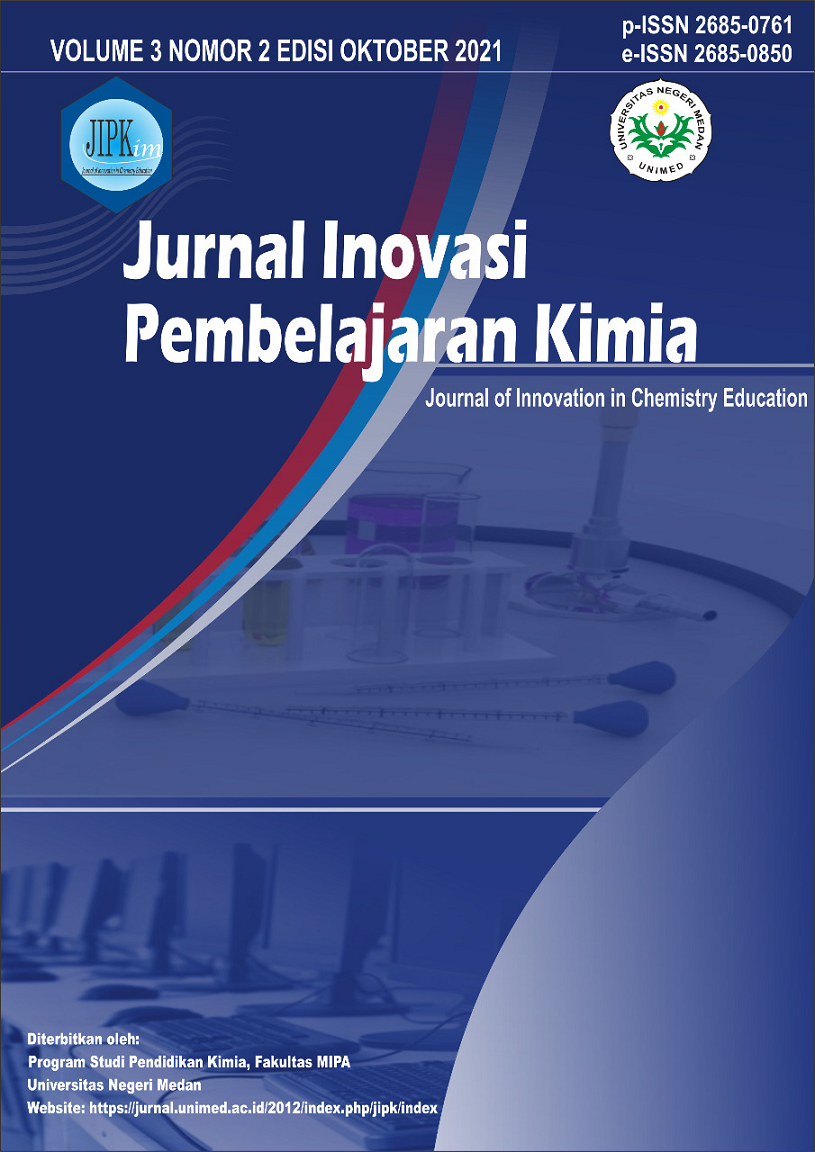Pengembangan Modul Pembelajaran Kimia Berbasis Proyek Pada Pokok Bahasan Termokimia Untuk Kelas XI SMA
DOI:
https://doi.org/10.24114/jipk.v3i2.26638Keywords:
Teaching Materials, Modules, Project Based Learning, BSNP, Student ResponseAbstract
This study aims to 1) find out whether the chemistry teaching materials used in high school on thermochemistry materials have been project-based, 2) find out whether the thermochemistry learning modules developed have met project-based studies, 3) find out whether the thermochemistry teaching materials developed have met the module requirements, 4) find out whether the chemistry learning module developed on thermochemical material is in accordance with the criteria set by the BSNP, and 5) find out how students respond to aspects of the appearance, material, and benefits of project-based thermochemical modules. The research method is Research and Development (R&D) with the ADDIE development model. The sample set in this research is 1) Chemistry Lecturer at State University of Medan as many as 3 people, 2) Chemistry teacher at SMA Negeri 2 Percut Sei Tuan as many as 3 people, and 3) Class XI science students at SMA Negeri 2 Percut Sei Tuan in 1 class with 20 students. person. The results of the analysis of teaching materials in schools show that books A and C are not based on Project Based Learning with a value of 1.44. Meanwhile book B deserves to be a Project Based Learning book with a value of 2.66. The results of the validation (syntax) of the PjBL model in the module obtained a content aspect score of 3.12 with appropriate criteria. In terms of the activity aspect, it has a score of 3.30, the condition aspect has a score of 3.50, and the outcome aspect has a score of 3.50 and the criteria are very feasible. The results of the BSNP standardization obtained a content feasibility value of 2.98 with appropriate criteria; and presentation feasibility 3.36; chart feasibility 3.33; the feasibility of the language is 3.36 with very feasible criteria so that the score of the four aspects of eligibility is 3.26 with very feasible criteria. It can be concluded that the developed module is suitable for use as teaching materials.References
Arikunto.S., (2006), Prosedur Penelitian Suatu Pendekatan Praktik, Rineka Cipta, Jakarta
Chiappetta, E.L., & Koballa, T.R. (2010). Science Instruction in The Middle and secondary School 7th Edition. Boston: Allyn & Bacon.
Fathurrohman, M., (2015), Paradigma Pembelajaran Kurikulum 2013, Kalimedia, Yogyakarta
Habok, A., dan Judit N., (2016), In‘service Teachers™ Perceptions of Project‘Based Learning, Springer Plus, 5(83) : 1-14
Khotim, H.N., Nurhahti, S., dan Hadisaputro, S., (2015), Pengembangan Modul Kimia Berbasis Masalah Pada Materi Asam Basa, Chemistry in Education 4 20 64 “ 69
Mardapi, D., (2007), Badan Standar Nasional Pendidikan, Jakarta
Prastowo, A., (2014). Pengembangan Bahan Ajar Tematik, Kencana, Jakarta
Sani, M., dan Joko., (2015), Pengembangan Modul Pembelajaran Berbasis Proyek Pada Mata Kuliah Pemeliharaan Dan Perbaikan Mesin Listrik Di Jurusan Teknik Elektro Universitas Negeri Surabaya, Jurnal Pendidikan Teknik Elektro 4 (1) : 259 “ 267
Sari, D. N. A., Ani R., dan Murbangun N., (2017), Pengaruh Pembelajaran Berbasis Proyek Terhadap Kemampuan Literasi Sains Siswa, Pancasakti Science Education Journal, 2(2): 114-124
Saricayir, H., Ay, S., Comek, A., Cansiz, G., & Uce, M. (2016). Determining Students™ Conceptual Understanding Level of Thermodynamics. Journal of Education and Training Studies, 4(6), 69-79.
Siwa,I.B., Muderawan, I.W., Tika, I.N., (2013) , Pengaruh Pembelajaran berbasis proyek Dalam Pembelajaan Kimia Terhadap Keterampilan Proses Sains
Sutirman, (2013), Media dan Model-Model Pembelajaran Inovatif, Graha Ilmu, Yogyakarta
Wena, M., (2011), Strategi Pembelajaran Inovatif Kontemporer, Bumi Aksara, Jakarta

